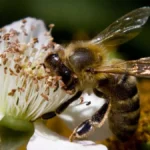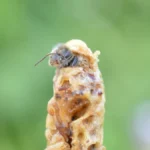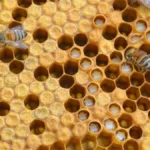In this article, we look at what happens to a hive when it is queenless and how long can a hive be queenless. You will see that a hive can be queenless for a short period of time before changes occur in the hive. If these changes reach a specific threshold, your hive becomes hopelessly queenless and the hive is to all intents and purposes lost.
What Happens If A Hive Loses Its Queen?
Queen bees sometimes die. Virgin queens have to go on mating flights, and sometimes they don’t come back. Sometimes a clumsy beekeeper will squash a queen by mistake when working a hive. There are many things that can cause a hive to lose its queen.
Rearing An Emergency New Queen
By far the best thing a hive can do if it finds itself without a queen is to rear a new queen from one of the last eggs the old queen laid. These queens are reared in emergency queen cells, and in some cases can be quite low quality.
The rearing of an emergency queen takes about 16 days. If this queen is able to take over the hive, the hive will be queenright again. However, if this queen were to get eaten by a bird, or get lost on her mating flight, the hive would now have no backup eggs.
What Happens If Rearing An Emergency Queen Is Not Possible?
In the event that there are no eggs, or the emergency queen dies as well, a hive will enter a situation where they cannot rear a new queen. In this case, the hive is basically up the creek without a paddle and is a hopelessly queenless hive.
A Hopelessly Queenless Hive
In a hopelessly queenless hive, there are no eggs left which workers can raise into queens.

Read more about: Beehive Frames Without Foundation
Under these circumstances there is no queen to maintain reproductive dominance and the workers will develop ovaries and start laying eggs. A queen is important to the structure of the hive as she is supposed to be the only reproductive female in the hive. If this balance of power shifts, the hive structure collapses.
Because a worker is unable to mate, the eggs she lays will be drone eggs. In one species of bee, Apis mellifera capensis, the workers have hacked the matrix and can lay clones of themselves. The Cape Honeybee is an entire encyclopedia of weird all on its own and we will briefly revisit these bees at the end of this article.
The drone-laying worker bees hope that their genes will at least manage to do something useful in the world and survive through the drones finding a queen to mate with. The hive will eventually run out of workers and fade away to its death.
Queenless Hive Behavior
When we open a queenless hive there are a few immediate signs. The hive will tend to make a strange hiss noise.
The bees tend to be a bit skittish and unsettled, and they lack the normal social cohesion we see in a hive.
When you blow smoke on bees in a hopelessly queenless hive they tend to make more of a hissing sound. The bees fly up from the frames quickly and dart around.
In many cases, they become less defensive. This is not a hard and fast rule, and I once was employed to make hopelessly queenless hives for a research project. I was savagely attacked by a hopelessly queenless hive. As bees get older their stings seem to get more unpleasant. This was a horrible event for me.
Queenless Hive Symptoms
A queenless hive displays very distinctive symptoms.
Early Stages: No Eggs
In the early stages of a queenless hive, you will find that the hive completely lacks eggs. There may be some capped brood, but an inspection of the brood frames will show a little capped brood, and then empty cells where eggs and larvae would normally be.
Advanced Stages: Lots Of Messy Eggs
In a hive without a queen, the workers begin to lay drone eggs.
A worker is not a queen and is not a talented egg layer. They tend to just lay eggs all over, and the bottom of a cell can look like a bowl of rice there are so many eggs laid there. The eggs are placed haphazardly and are not centered in the cell.
A few of the eggs hatch and become larvae and some workers provide these with mediocre care. In many cases, you can end up with multiple hatched larvae in one cell, which is an untenable situation.
As the condition of the hive progresses, you eventually end up with a patchy mess of drone brood, and in some cases, the workers even try and raise drones in worker cells, which is a disaster. The workforce in the hive begins to decline and the guards at the entrance get old.
After 6 or 7 weeks, other hives will rob whatever resources are left in the hive, and the hive collapses. It is a very sad state of affairs watching a once proud hive suffer this social collapse. In many ways, this is a warning to humans of what happens when the pillars of a society are removed and you end up with a failed state. A queenless hive is a failed state.
Apis Mellifera Capensis
If a hive of these bees loses its queen and becomes hopelessly queenless, it is not in fact hopelessly queenless. The Cape Bee can lay fertilized eggs through a process called thelytoky. These eggs hatch and produce worker bees that are near clones of the parent worker.
With time, an army of clones of one worker mother pseudo queen will rear a queen from one of their eggs and this queen will emerge victoriously.
Cape Honeybees have an aggressive pheromonal system, and if a Cape Bee finds her way into a beehive of another race of bees, she will become a pseudo queen, and lay eggs in that hive leading to the demise of the proper queen in the hive. This leads to a collapse of the hive.
Read more about: Splitting A Hive To Prevent Swarming

Dr. Garth A. Cambray is a Canadian/South African entrepreneur and beekeeper with 28 years of experience in apiculture and specializes in adding value to honey. His Ph.D. research developed a new advanced continuous fermentation method for making mead that has resulted in a number of companies globally being able to access markets for mead. His company, Makana Meadery, exports honey mead to the USA where it is available to discerning connoisseurs. He has also developed technologies to commercially manufacture organic honey vinegar in Zambia for export globally. He holds a few patents globally in the ethanol industry and believes in technology and knowledge transfer for human development and environmental sustainability. One of his proudest achievements is the fact that the wind farm he started at one of his old apiary sites has essentially made his hometown carbon neutral.






